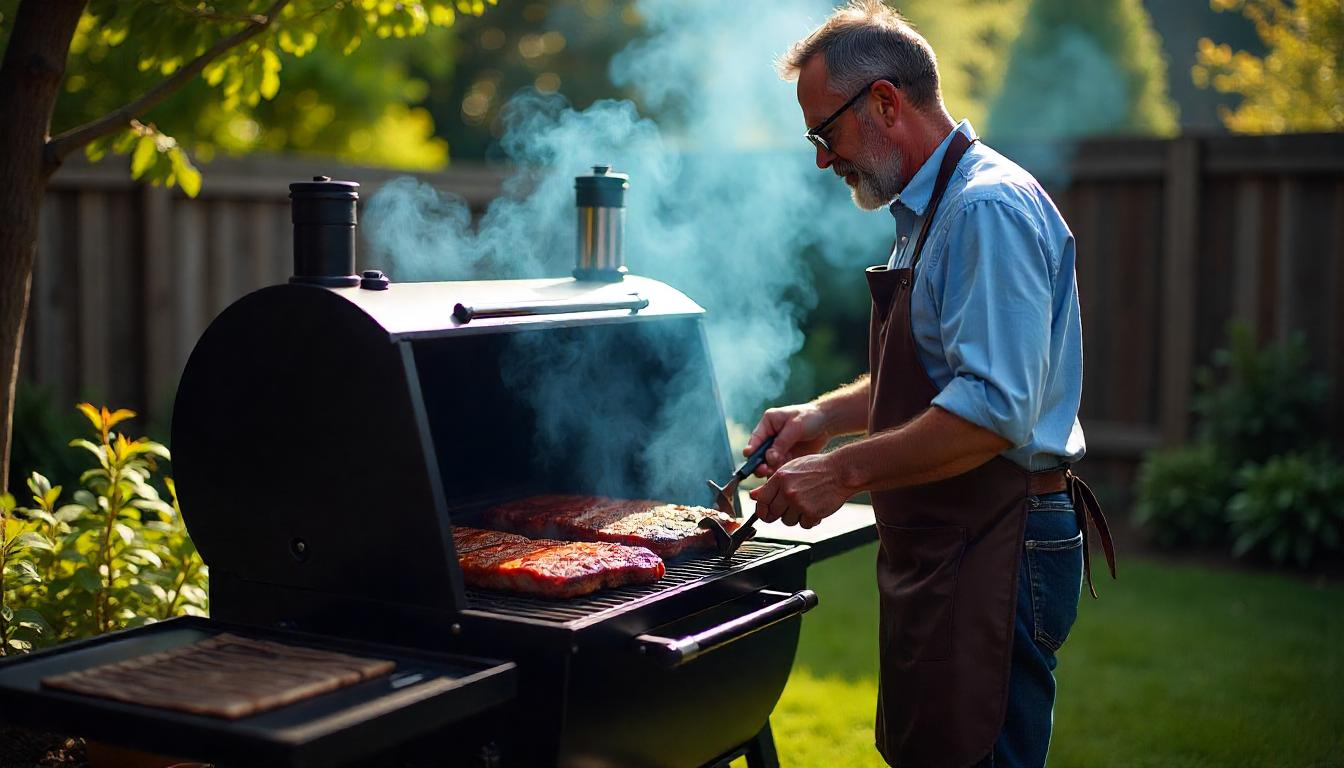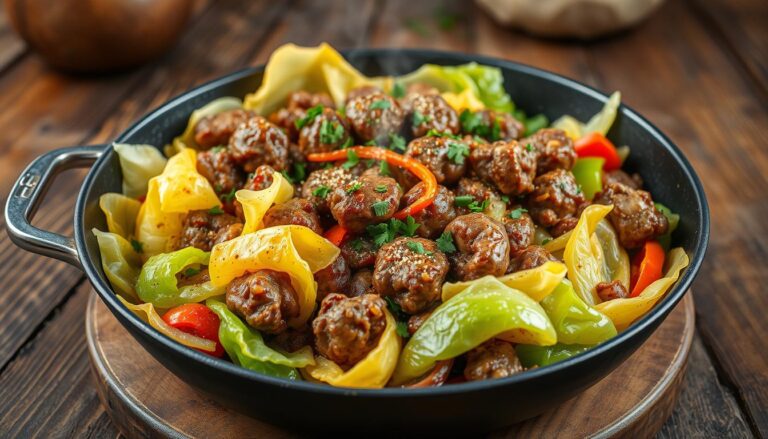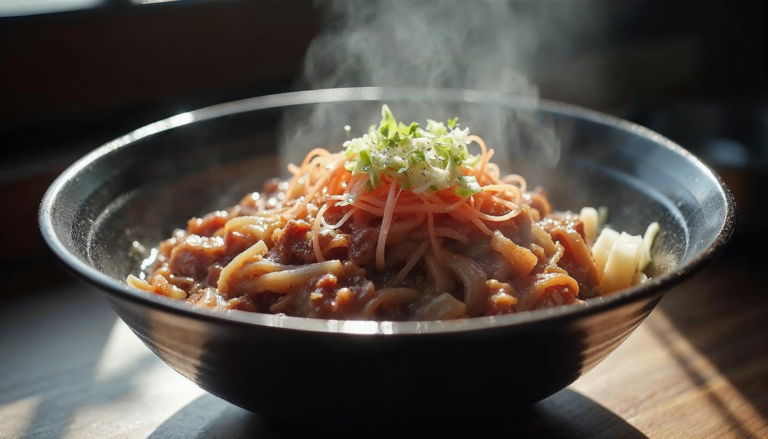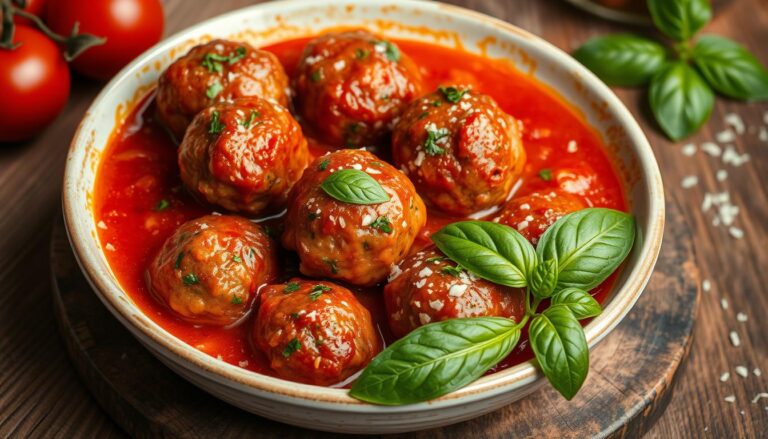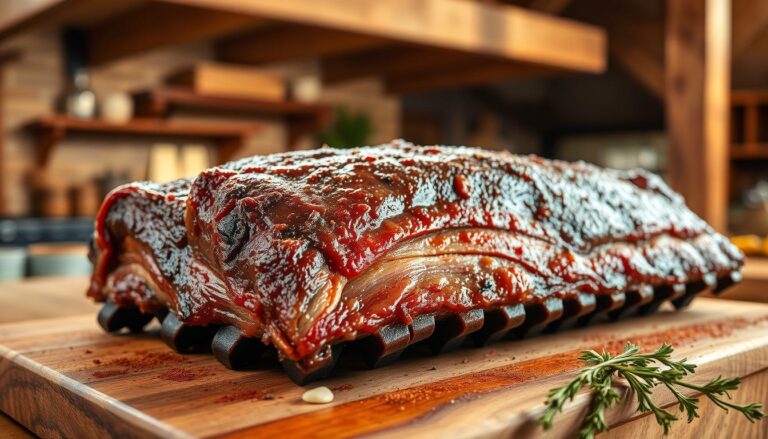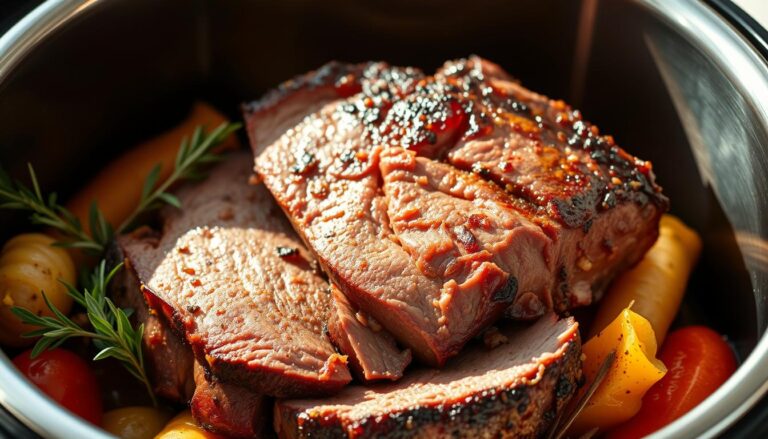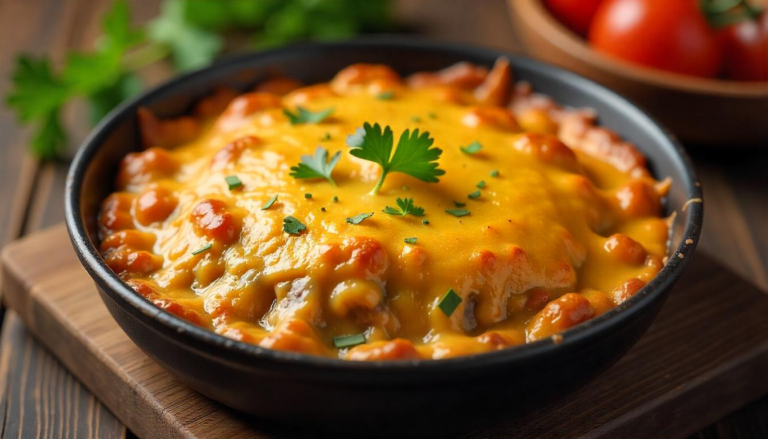How to Use a Beef Ribs Smoker

The first time I fired up my beef ribs smoker, the smell turned my backyard into a kitchen paradise. Smoking beef ribs is more than cooking—it’s a tradition that connects us to our past. Whether you’re a casual griller or a dedicated pitmaster, learning to use a beef ribs smoker can make your cooking amazing.
Smoking beef ribs needs patience, precision, and love. You start by learning the basics of slow cooking. A beef ribs smoker is not just a tool—it’s your way to make delicious, tender meat that’s easy to pull apart.
Every time you smoke beef ribs, it’s a new adventure. How you control the temperature, choose your wood, and use your technique will make or break your dish. With the right steps, you can turn simple beef ribs into a dish that will impress everyone.
Table of Contents
Key Takeaways
- Master temperature control for perfect beef ribs
- Choose the right wood for optimal smoke flavor
- Understand the importance of low and slow cooking
- Invest in quality beef ribs smoker equipment
- Practice patience during the smoking process
Understanding Different Types of Beef Ribs
beef ribs smoker
When cooking beef short ribs in the oven or smoker, knowing your rib cuts is key. Each type of beef rib has its own flavor, tenderness, and cooking experience.
Beef ribs come in several distinct types, each with its own culinary profile:
- Back Ribs: Cut from the prime rib roast, these ribs are known for their exceptional tenderness
- Plate Short Ribs: Located near the belly, these ribs offer a higher meat-to-bone ratio
- Chuck Short Ribs: Cut from the shoulder area, packed with rich marbling
Meat-to-Bone Ratio Differences
When picking beef short ribs for oven cooking, the meat-to-bone ratio matters. Plate short ribs have more meat than back ribs. This makes them great for smoking and roasting.
Quality Grades and Selection
The USDA grading system helps you choose top-notch beef ribs. Prime, Choice, and Select grades show different levels of marbling and tenderness. For the best taste, choose ribs with plenty of marbling and even fat distribution.
Pro tip: Ask your local butcher about the specific cut and grade of beef ribs to ensure the highest quality for your cooking method.
Essential Equipment for Smoking Beef Ribs
Smoking beef ribs is more than just cooking meat. You need the right tools to make your barbecue legendary. These tools help control temperature, manage smoke, and prepare delicious meat.
For a mouthwatering result, you’ll need several key pieces of equipment.
Smoker Types for Perfect Beef Ribs
Different smokers offer unique qualities for your beef ribs BBQ:
- Offset smokers: Traditional design with separate firebox
- Pellet grills: Precise temperature control
- Ceramic kamado grills: Excellent heat retention
- Charcoal smokers: Classic flavor profile
Critical Temperature Control Tools
Accurate temperature monitoring is key for tender beef ribs:
- Digital instant-read thermometers
- Wireless meat thermometers
- Smoker temperature gauges
- Heat-resistant gloves
Must-Have Beef Ribs BBQ Accessories
Upgrade your smoking experience with these essential accessories:
- Sturdy cutting board
- Spray bottle for moisture
- Wood chunks for smoke flavor
- Butcher paper for wrapping
- Basting brushes
- Meat injectors
“The right tools transform good meat into a barbecue masterpiece.”
Quality equipment makes every beef ribs BBQ a delicious adventure.
Preparing Your Beef Ribs for the Smoker
Getting your beef ribs ready for smoking is an art. It turns good meat into amazing barbecue. These big cuts need careful prep to reach their best.
First, work on the meat’s outside. Trim the fat, but not too much. This keeps the ribs juicy. Here’s how to prepare them:
- Remove the silver skin from the meat side of the ribs
- Trim excess fat, keeping a thin layer for flavor
- Pat the ribs dry with paper towels
Your marinade is key for flavor. Many use a dry rub, but a marinade adds depth. Try a Texas-style mix:
- 50/50 coarse salt and black pepper
- Garlic powder
- Smoked paprika
- Optional: Worcestershire sauce for extra tang
“Preparation is the secret to championship-level beef ribs.” – BBQ Pitmaster
Pro tip: Chill your seasoned ribs for 24-26 hours before smoking. This lets the marinade soak in, making the ribs tender and flavorful. Remember, patience is key to making great ribs.
Mastering the Beef Ribs Smoker Technique
Smoking beef ribs is an art that needs precision and patience. Your beef ribs smoker can turn tough cuts into delicious treats with the right techniques. It’s all about understanding the elements that affect flavor, tenderness, and quality.
The secret to great beef ribs is in managing temperature and choosing the right wood. Your method will make or break the taste and texture of your barbecue.
Temperature Management Essentials
Keeping a steady temperature is key when smoking beef ribs. Aim for a temperature between 225°F and 250°F. If the temperature varies, your meat might end up tough.
- Use a reliable digital thermometer
- Check smoker temperature every 30 minutes
- Adjust vents to control heat
Selecting the Perfect Smoking Wood
The wood you choose greatly affects the flavor of your beef ribs. Here are some traditional options:
| Wood Type | Flavor Profile | Best For |
|---|---|---|
| Oak | Strong, classic barbecue flavor | Traditional Texas-style ribs |
| Hickory | Bold, bacon-like taste | Robust beef cuts |
| Cherry | Mild, slightly sweet | Balanced flavor profile |
Time and Temperature Guidelines
Smoking beef ribs is about patience, not time limits. It can take 5-10 hours, depending on the meat’s thickness.
“Low and slow is the golden rule of smoking beef ribs.” – BBQ Pitmaster
- Target internal temperature: 203°F
- Use the “bend test” to check doneness
- Rest ribs for 30-45 minutes after smoking
Pro tip: Avoid the Texas crutch of wrapping ribs in foil. Let the meat develop a beautiful bark and absorb smoky flavors naturally.
Creating the Perfect Dry Rub
Making the perfect dry rub is key to delicious beef ribs BBQ. The right spices can turn your meat into something amazing. It will impress anyone who loves BBQ.
Think about mixing sweet and savory flavors with a bit of heat. This mix will make your meat taste great.
Classic Memphis-Style Dry Rub Ingredients
- 3 Tablespoons smoked paprika
- 3 Tablespoons Kosher salt
- 1 Tablespoon black pepper
- 2 Tablespoons dark brown sugar
- 2 teaspoons garlic powder
- 2 teaspoons onion powder
- 1 teaspoon dried oregano
- 1 teaspoon celery seeds
- 1 teaspoon ground mustard powder
Here are some tips for applying your dry rub:
- Season both sides of the ribs well
- Press the seasoning in with your hands
- Use about 2 tablespoons per side
- Keep the smoker temperature below 265°F to avoid burning
Binder Techniques
Using a binder can help your seasoning stick better. Common binders include:
- Olive oil
- Mustard
- Worcestershire sauce
- Vegetable oil
Remember, use binders sparingly. They help keep meat juices in and prevent greasiness.
Monitoring and Maintaining Proper Smoke Levels
beef ribs smoker
Mastering your beef ribs smoker needs careful attention to smoke quality. The secret to amazing smoked beef ribs is knowing how to manage smoke. This turns simple meat into a culinary masterpiece.

Smoke is the key to a successful beef ribs smoker. Professional pitmasters know that not all smoke is the same. You should aim for thin, blue smoke. This is better than thick, white smoke that can mess up the flavor.
Smoke Ring Development
The smoke ring is a prized feature in smoked meats. It’s created by a chemical reaction between meat proteins and carbon monoxide. To get a great smoke ring:
- Maintain temperatures between 225°F and 250°F
- Use drier meat cuts for better smoke absorption
- Choose woods like oak or hickory for optimal results
Managing Air Flow
Proper airflow is key in your beef ribs smoker. Controlling air vents keeps smoke and temperature consistent. Here are some techniques:
- Adjust vents gradually
- Use water pans to stabilize temperature
- Avoid opening the smoker unnecessarily
Troubleshooting Common Issues
When smoking beef ribs, you might face challenges. Quick action can save your cook:
- White smoke indicates incomplete combustion
- Inconsistent temperatures can dry out meat
- Overly thick smoke creates bitter flavors
“The difference between good and great barbecue is in the details of smoke management.” – BBQ Expert
Investing in digital thermometers and understanding your smoker’s unique traits will take your smoking to the next level.
Texas-Style Smoking Methods
Texas-style barbecue turns beef short ribs into a true masterpiece. It uses special smoking techniques. Unlike cooking in the oven, authentic Texas methods require a smoker for the best flavors.
The traditional Texas way aims for a great bark and deep smoke taste. Pitmasters stick to these main steps:
- Keep the smoker at 250°F all the time
- Use oak or pecan wood for that real smoke taste
- Season with just salt and pepper
- Cook until the meat hits 195-207°F
There are two main smoking methods in Texas barbecue:
- Unwrapped Method: Smoke ribs without wrapping to get a strong bark
- Texas Crutch: Wrap ribs in pink butcher paper halfway through
Important smoking details for beef short ribs include:
| Parameter | Recommended Setting |
|---|---|
| Smoker Temperature | 225-250°F |
| Cooking Duration | 4-5 hours |
| Final Internal Temperature | 195-207°F |
While oven-cooked beef short ribs are good, Texas-style smoking is better. It’s all about patience, keeping the temperature right, and knowing your smoking method.
Tips for Achieving Tender and Juicy Results
Smoking beef ribs is an art that needs patience and precision. The secret to delicious beef ribs is mastering key techniques. These techniques turn tough meat into a tasty feast. Your marinade and preparation are key to avoiding dry, tough meat.

Wrapping Techniques for Maximum Moisture
Professional pitmasters use the Texas crutch method to keep meat moist. Wrapping ribs in aluminum foil during the last stage helps keep juices in. Here are some wrapping tips:
- Wrap ribs when they reach an internal temperature of 160°F
- Use heavy-duty aluminum foil for best results
- Add a splash of beef broth before sealing to enhance moisture
Spraying and Moisturizing Secrets
Keeping your beef ribs moist is key. A good marinade or spritz can prevent drying and add flavor. Try this simple spraying technique:
- Mix ½ cup apple cider vinegar with 1 tablespoon hot sauce
- Spritz ribs every hour during smoking
- Maintain a consistent 250°F smoker temperature
The Crucial Resting Period
Never skip the resting time for your smoked beef ribs. After hours of smoking, let them rest for 15-20 minutes. This step ensures each bite is tender and full of flavor.
Pro tip: Wrap the ribs in butcher paper during the resting period to keep them warm while allowing some moisture to escape.
Conclusion
Smoking beef ribs is an art that turns simple meat into a masterpiece. Your journey into beef ribs BBQ needs patience, practice, and passion. It’s all about controlling temperature, choosing quality meat, and finding your own smoking style.
Every time you smoke, you get better. Keeping temperatures between 225°F and 250°F is key for tender ribs. The secret is in the temperature, wood flavors, and seasonings you use.
Feel free to try new glazes and rubs. Add your own twist, whether it’s a Texas-style bark or a Caribbean sweet touch. Your unique touch makes each rib special. Enjoy the learning, track your progress, and share your tasty ribs with loved ones.
With time, you’ll go from a beginner to a BBQ pro. Your adventure in smoked beef ribs is about making unforgettable meals. It’s about enjoying the deep, smoky flavors that true BBQ lovers cherish.
FAQ
What’s the difference between beef back ribs and plate ribs?
Beef back ribs come from the top of the rib cage near the spine. They have less meat and are leaner. Plate ribs, on the other hand, are from the lower part of the cow. They have more marbling and meat, making them great for smoking.
Back ribs are often cheaper. But plate ribs are loved for their rich flavor and tender texture.
What type of smoker is best for beef ribs?
The best smoker depends on your experience and what you like. Offset smokers give traditional barbecue flavor. Pellet grills are easy to use because they control temperature well.
Vertical smokers keep heat steady. Kamado-style grills, like the Big Green Egg, are great for keeping temperatures even during long smokes.
How long does it take to smoke beef ribs?
Smoking beef ribs takes 6-8 hours at 225-250°F. The goal is to cook them until they’re tender. You can check this by doing the bend test.
The ribs should bend easily without breaking when picked up with tongs.
What wood is best for smoking beef ribs?
Post oak, hickory, and mesquite are top choices for beef ribs, like in Texas-style barbecue. Post oak gives a mild flavor. Hickory has a stronger smoke taste. Mesquite adds a bold flavor.
For beginners, post oak is a good choice. It complements beef without overpowering it.
Do I need to remove the membrane from beef ribs?
Yes, removing the membrane is a good idea. This tough layer stops smoke and seasonings from getting to the meat. It can also make the ribs chewy.
Use a butter knife to lift the membrane at one end. Then, pull it off completely using a paper towel for better grip.
Can I smoke beef ribs in the oven?
You can try to smoke beef ribs in the oven. Use a low temperature (around 275°F). Place wood chips in a foil packet.
Cook the ribs on a rack with a water pan to keep them moist. But, the oven won’t give the same flavor as a dedicated smoker.
What’s the best rub for beef ribs?
A classic Texas-style rub is coarse kosher salt and black pepper in equal parts. For more flavor, add garlic powder, paprika, or chili powder. Use a coarse grind for a robust bark.
How do I know when my beef ribs are done?
Check if the ribs are done by using the bend test or checking the internal temperature. They’re done at 203-205°F and bend easily. The meat should pull back from the bone, showing tenderness.
Always use a reliable meat thermometer for accurate results.
Should I wrap my beef ribs while smoking?
Wrapping is optional but can help manage moisture and speed up cooking. Use butcher paper for a traditional Texas-style approach. This keeps the bark crisp.
Aluminum foil works too but can soften the bark. Unwrapped ribs get a more intense bark but may cook unevenly.
What USDA grade is best for smoking beef ribs?
USDA Prime is the highest quality, with lots of marbling and flavor. USDA Choice is a good alternative with good marbling at a lower price. USDA Select can work but may be less tender and flavorful.
For the best smoking results, choose well-marbled cuts.

